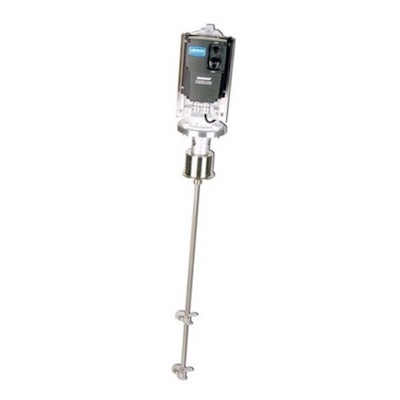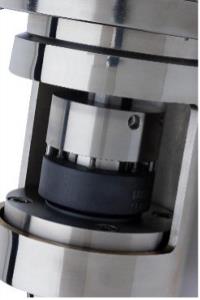What to Look for in a Pharmaceutical Mixer

Pharmaceutical grade liquid formulations are produced in an almost infinitely long list of products including external treatments, oral medications and injectables. Examples include over-the-counter products such as anti-bacterial ointments, contact lens solutions, cough medications and allergy medicines. Injectables is an incredibly diverse category that encompasses vaccines, maintenance medications such as insulin and many more liquid compounds. The process facilities in which the ingredients for these products are mixed range from small, independent laboratories compounding specialized batches to monstrous sanitary production plants running very large volumes of multiple products. These facilities are held to high sanitary standards for process control as well as the overall production environment and must meet guidelines set by the Food and Drug Administration. Process qualifications are generally defined by standards such as cGMP, short for current Good Manufacturing Processes used in the pharmaceutical industry. Standards related to processing equipment, such as pharmaceutical mixers and mixing tanks, include the ASME standard for Bioprocessing Equipment (BPE) design and procedures for clean in place (CIP) and sanitize in place (SIP) processes. The need to meet all of these standards falls upon providers of mixing equipment that is specialized for the pharmaceutical and bioprocessing industries.

Requirements for Sanitary Mixers

- Mixers for the pharmaceutical and biotech industries have design features that significantly differ from equipment used in more industrial settings. Materials of construction must withstand cleaning and sanitizing solutions without corrosion or degrading. For this reason, most mechanical components of sanitary mixers are free of paint or other coatings. Although some epoxy finishes suitable for “washdown duty” are accepted in some applications, the general trend is toward paint free components constructed of stainless steel or other corrosion resistant alloys.
- The surface finishes of materials internal to the mixing vessels are polished to a highly reflective appearance and are needed to meet requirements for surface finish roughness defined in terms of a roughness average (Ra) measurement using a profilometer. The resulting finish minimizes opportunity for bacterial growth and facilitates cleaning between each use.
- Another feature differentiating a sanitary mixer from industrial mixers is that processing of the batch requires an aseptic seal such that materials and fumes remain enclosed in the vessel and contamination from the external environment is prevented. Therefore, mechanical seal components are employed. Each seal consists of a rotating and stationary component. O-ring and gasket materials are used between the mixer shaft and the rotating half of the seal as well as between the stationary portion and the seal housing. Two extremely flat carbon and/or carbon silicon surfaces run face to face allowing rotation with extremely low leakage rates. Similar to the mixer and tank materials, mechanical seal materials must be selected based on the properties of the formulation to be mixed as well as sanitizing processes.
Pharmaceutical Mixing Equipment
INDCO produces sanitary mixers suitable for various degrees of aseptic mixing. The TCM-series mixers, such as the TCM-3-100V, 1 Hp Variable Speed Direct Drive Tri-clamp® Mixer and the TCMG-4-100V, 1 Hp Variable Speed Gear Drive Tri-clamp® Mixer, feature a mechanical seal that is internal to the vessel and often chosen for non-ingested formulations. The former is a higher speed range, direct drive option where vigorous agitation of light viscosity formulations is needed and the latter is gear-driven to drive larger impellers for either larger vessels of low viscosity liquids or high viscosity formulas where higher torque and greater surface area contact at the impeller is required. For applications demanding the highest degree of sealed vessel protection, the Ph-series features externally mounted seal designs and can include a flushable debris well which affords greater protection between the seal faces and the materials being mixed. Many customizations to units such as the PhD-100T3, 1 Hp Direct Drive Tri-clamp® Mixer, and the PhG-100T3, 1 Hp Gear Drive Tri-clamp® Mixer, are available including mixing impellers matched to the mixing intensity demanded by each process and in-tank couplers which allow removal of the lower mixer shaft and impellers for service or cleaning. For a more modular approach to mixing multiple smaller vessels in a laboratory setting the PhGM-series, such as the PhGM-500 T3, ½ Hp Gearmotor Tri-clamp® Mixer, features a removable drive gearmotor assembly that can be used to drive multiple lower assemblies that remain tank mounted.
Custom Designed Pharmaceutical Mixing Equipment
Although INDCO presents a wide range of standard pharmaceutical grade mixers it is most common that each mixer sold is custom designed for a specific application. To meet these needs, it is highly recommended that each customer consult with our engineering staff to ensure that mixer selection is compatible with the type or intensity of mixing required and that all necessary design modifications are included. There is never a charge for assistance in sizing or otherwise scoping a mixer. Call us today at (800) 851-1049 to discuss your sanitary or pharmaceutical mixer needs!® Tri-clamp is a registered trademark of the Alfa Laval Company.
